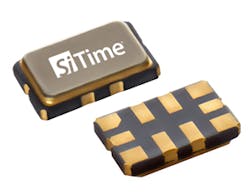Maximizing MEMS for Precision Timing Devices
Numerous different signal-source technologies will be on display at the 2018 IMS exhibition, including temperature-compensated crystal oscillators (TCXOs) and oven-controlled crystal oscillators (OCXOs) based on crystal resonators. Additional technologies include surface-acoustic-wave (SAW) resonators and bulk-acoustic-wave (BAW) oscillators.
One of the more recent precision source technologies, microelectromechanical-systems (MEMS) technology, will also be demonstrated for visitors to the SiTime Corp. (booth 1433) in the 5G Pavilion on the 2018 IMS exhibition floor. These MEMS-based timing solutions are expected to provide solutions in emerging 5G wireless networks.
This next generation of wireless technology is being touted as a design that will quickly leave 4G Long Term Evolution (LTE) cellular communications systems behind. The wireless radio-to-radio accuracy of 5G handsets must be within 65 ns, or about 20 times faster than current 4G LTE systems and handsets.
The Elite family of Super-TCXOs from SiTime Corp. are precision timing oscillators based on MEMS technology and supplied in compact housings, such as the SiT5356, available from 1 to 60 MHz in 1-Hz steps. (Courtesy of SiTime)
Such timing and synchronization of communications devices requires clock oscillators with outstanding stability even with fast switching speed. MEMS technology is being presented by SiTime among others as that timing solution for 5G, while also operating at a fraction of the power of traditional clock oscillators, such as TCXOs and OCXOs. At the 2018 IMS, SiTime will showcase its Elite family of Super-TCXOs based on MEMS technology (see figure).
As an example, the SiT5356 is a MEMS-based Super-TCXO with ±100-ppb precision that’s available for any frequency in 1-Hz steps from 1 to 60 MHz. It employ’s the company’s unique DualMEMS temperature-sensing and Turbo Compensation technology to maintain outstanding stability even with changes in vibration, shock, temperature, and electromagnetic interference (EMI). It’s usable over an operating temperature range of −40 to +105°C.
Visitors to the 5G Pavilion Theatre at specific times can witness dynamic comparisons of these MEMS clock oscillators with alternative quartz-crystal clock oscillator technologies, as part of a presentation “Overcoming 5G Time Synchronization Challenges.” One presentation, for example, is scheduled for Thursday, June 14, from 10:00 to 10:30 am.


